More misery for Southland farmers. PAGE 4
HIGH AMBITION Dream comes true


More misery for Southland farmers. PAGE 4
HIGH AMBITION Dream comes true

After 25 years of governance roles Jim van der Poel is ready to pass the baton to the next generation.
PAGE 5













You’ve always tried to breed from your best, and you already know the power of genomics. Through our new GeneMark® Genomics service, you can continue to identify superior genetics with increased reliability at a younger age.
GeneMark Genomics takes the guesswork out of matching calves to parents while accessing genomic data, adding precision to your animals’ breeding values at a more cost-effective price.
All of which helps you fast-track your herd’s genetic gain.
So continue breeding from your best and building your confidence with GeneMark Genomics.
Talk to your Agri Manager today or visit lic.co.nz/genemark

There's always room for improvement



SUDESH KISSUN sudeshk@ruralnews.co.nz
FALLING INTEREST rates, combined with a rising forecast milk price, mean this season’s looking a lot better than the previous one, says Federated Farmers dairy section chair Richard McIntyre.
McIntyre says farmers expect banks to pass the official cash rate (OCR) cuts onto farmers. Last week the Reserve Bank cut the OCR by 50 basis points to 4.75%. Further cuts are expected in the coming months.
McIntyre says while farmers welcome the cuts, they want the focus on “the systemic issues affecting interest rates”.
“Falling interest rates will be welcome news for farmers, and when you combine them with a rising milk price, this season will almost certainly look a lot better financially than the last,” he told Dairy News
“That being said, Federated Farmers are more focused on the systemic issues affecting interest rates. Interest rates rise and fall in cycles, but if we can get the settings right, farmers will consistently pay lower interest rates and get better service no matter where we are in that cycle.”
The lower interest rates and a near-record milk price this season are also expected to boost farmer spend this season. ANZ last week became the latest bank to lift its forecast farmgate milk price to $9/ kgMS, matching Fonterra’s midpoint.
ANZ agriculture economist Susan Kilsby says a $9 milk price would allow many farmers to spend on the repairs, maintenance and fertiliser that many cut back on last

season.
“We also expect the higher returns to result in an increase in principal debt repayments,” she says.
ANZ is predicting another 50bp cut to the OCR next month.
Kilsby notes that the market is confident of a series of rapid drops in the OCR and that has fed through into lower rates across the yield curve.
“This, in turn, has resulted in lower fixed mortgage rates on offer to businesses and individuals.”
However, farmers are not convinced that they’re getting a good deal from the banks.
Last week Federated Farmers made its submission to Parliament’s banking inquiry: it included more than 1500 comments from farmers fed up with paying over the odds for
banking services.
“Lack of competition in rural banking, unfair practices, unjustifiably high interest margins and overly cautious Reserve Bank restrictions are seriously disadvantaging the nation’s food producers and export income earners,” McIntyre says.
Federated Farmers believes farmers are currently paying up to 1.7% more in borrowing costs than they should in a fair and open market.
“We’re calling for urgent banking reform in the agricultural sector, where $62.5 billion in lending means even a 1% difference in margins represents $625 million,” McIntyre says.
One of Federated Farmers’ key recommendations is for the Government to revise the Reserve Bank’s stringent one-in-200-year financial shock standard, which significantly raises borrowing costs for farmers.
Moving to a one-in-100-year standard would still ensure stability while lowering costs for rural borrowers, McIntyre says.
More than one in five Kiwi farmers say their bank isn’t allowing them to structure their debt to minimise interest payments as much as possible.
Too many farmers say they are pressured to use overdrafts to manage debt repayments or fund capital projects – tasks overdrafts were never intended for.
In fact, 12% of farmers say their bank has asked them to fund capital work using an overdraft.
“This is unacceptable,” McIntyre says.
“Overdrafts are designed for managing seasonal cash flow, not to burden farmers with higher-interest debt to boost bank profits.”

SOUTHLAND FARMERS
have been assured that, while concerning, there are no immediate implications from a court decision which requires them to apply for a resource consent just to continue farming.
Federated Farmers
Southland spokesperson Bernadette Hunt says about 3000 farmers in the region, already under the pump with prolonged rainfall and flooding, don’t need more headaches.
Hunt told Dairy News that Federated Farmers is extremely disappointed at the decision and are working through a range of channels to decide on next steps and take appropriate action.
“There’s a process to
go through now before any changes come into force, and that will take time in any case – therefore there are no immediate implications for farmers to be concerned with.
“Farmers in Southland are under immense pressure with the current weather conditions and I’m very concerned that this doesn’t add to that mental burden.”
The Southland Water and Land Plan was notified in 2016. Rule 24 –which seeks to allow incidental diffuse discharges from farming activities (e.g. animal urine) as a permitted activity provided farming activities are managed under other rules in the plan – was initially appealed to the Environment Court by Forest & Bird and Fish & Game. The court subsequently

questioned whether the rule complied with Section 70, particularly in relation to degraded water bodies.
Environment Southland appealed the decision to the High Court and then the Court of Appeal, but has been unsuccessful. All courts
have now indicated they do not consider that Rule 24 currently complies with Section 70 of the RMA.
ES chief executive Wilma Falconer says the council has written to the Government outlining the situation and requesting an urgent change to
Section 70 as part of its review of the RMA, to address the issue.
Federated Farmers says the decision has a range of very complicated consequences with extraordinary economic implications.
Hunt says farmers can be assured that Feder-
ated Farmers will not let this lie.
“This ruling, which if it stands means more costs and red tape for farming businesses, couldn’t have come at a worse time. Many farming families and businesses are under the pump with the high rainfall, flooding and related disruption and costs. It’s just more stress piling on farmers.”
Hunt says decisions like this show just how deeply broken New Zealand’s resource management laws have become.
“The Resource Management Act has gotten so far away from its original purpose and intent. It was supposed to be enabling, but it’s become overly complex and restrictive.
“The entire process has been hijacked by environmental activist
BANKS AND rural businesses are chipping in to help farmers in Southland and Otago.
Ballance Farm Nutrients general manager for customers, Jason Minkhorst, spent much of last week driving around the two provinces to get a first-hand look at effects of the Otago floods and ongoing wet in Southland.
He says he saw significant flooding on the Taieri Plains with large areas of pasture under water and says it’s hard to imagine how farmers are coping
milking cows and dealing with newborn lambs.
“But moving into Southland there is clearly a serious problem with the availability of feed and farmers have been doing it tough there for some time. I have been talking to farmers and they are saying these are some of the worst conditions they have ever faced,” he told Dairy News.
Minkhorst says Ballance is now putting together a package that will help them though this bad patch.
The ANZ Bank has also put up its hand to help farmers, with Lorraine Mapu, managing director of business and agri, saying the current economic environment means many farmers are already doing it tough, and this extreme weather comes at a critical period on the farm – during calving and lambing.
She says they have got staff on the road talking with and visiting farmers in some of the worse affected areas, to get a better idea of the extent of the damage.
“As things dry out and the cleanup starts, we want to reassure our farming customers that the bank is here to work with them in the days and months ahead,” she says.
Westpac NZ managing director of consumer banking and wealth, Helen Ryder, says the bank is on standby to provide emergency financial support, but its top priority is the safety of customers and staff.
Ryder says it is making targeted
groups like Fish & Game and it’s now almost impossible to do anything productive.”
Hunt says piecemeal, one-off changes dripfed from the courts over the last 30 years, rather than systematic improvements, have just added cost and complexity.
“The Government are currently in the process of replacing the Resource Management Act, which is welcome news and long overdue, but that’s a longer-term solution.
“In the short-term, farmers are still stuck farming under the current rules that have become completely unworkable and unaffordable.
“We need a practical, commonsense solution to bridge the gap between today and whenever our new resource management laws arrive.”
assistance available for business and farming customers, subject to approval including temporary overdraft facilities and the ability to defer loan repayments or moving to interest only, to help ease some financial pressure.
She says help could include suspension of principal payments on loans for up to three months, deferred payment on credit cards for up to three months and a temporary overdraft facility. – Peter Burke

WAIKATO FARMER Jim
van der Poel’s foray into dairy industry governance began 25 years ago with a bang.
He stood against then industry heavyweight and New Zealand Dairy Board chair John Storey in the Te Awamutu ward – and won. A group of farmers asked him to stand. He recalls visiting every farmer in the ward during the election campaign.
“It was a big deal back then,” van der Poel told Dairy News.
The massive win was the start of a journey that will end next week when van der Poel steps down as DairyNZ board member and chair at its annual meeting in Christchurch.
Van der Poel has been chair of DairyNZ since
2017, following his election to the board in 2013. He served as a farmerelected director on the inaugural board in 20072009, then again from 2013. Prior to this, he was appointed to the foundation board of DairyNZ’s predecessor Dexcel in 2000, becoming chair in 2003.
During his third reappointment as chair in October last year, van der Poel said he would remain to support the transition of new chief executive Campbell Parker, the development of DairyNZ’s new strategy, and see through the change of government.
“DairyNZ is in good health and it’s time to pass the baton to the next generation,” he says.
“I have confidence in the depth of the board, the direction of the new chief executive and strategy, and am happy to

be handing over duties to the new chair in an orderly way over the next few months.
“In less than a year, Campbell Parker has set a new strategic direction which rightly refocuses the organisation on the future, science and research, and profitability.
“The dairy industry
has been good to me, and it’s been my privilege to give back,” he says.
Van der Poel has always been keen to contribute to progress in the industry.
“For me, it’s my personality, where I believe something needs to be done, I find the need to stand up and do some-
FARM SALES are on the rise. According to recent data from the Real Estate Institute of New Zealand (REINZ), there was an 18.9% increase in farm sales for the three months ending August 2024 compared to the same period in 2023.
However, this was still a 10% decrease on the 231 sales recorded for the three months ending July 2024.
In total, 923 farms were sold in the year to August 2024, a decline of 166 farms compared to the previous year.
Overall, the REINZ All Farm Price Index showed stability, with a slight decrease of 2.1% in the three months leading up to August compared to July.
The three months leading to August 2023 marked a 3.2% decline.
thing about it.
“When I first stood in the NZDB days, we were thinking about merging and how to deregulate the industry. I found a need to stand up and have a view and participate and engage.”
Van der Poel was also part of Fonterra’s formation. The first attempt to
REINZ rural spokesman Shane O’Brien says that despite the headwinds currently faced by the rural sector, it is encouraging to see sales levels reach the same levels of the past two years, with 57 sales recorded in August 2024 compared to 55 in August 2022 and 51 in August 2023.
“August is traditionally a slow month for sales as many sellers wait
merge NZ Dairy Group and Kiwi Dairy Co-op fell through, he recalls.
“It didn’t get enough support and both parties went to their own and reflected. The logic was so strong that the risk of splitting everything and destroying value wasn’t an option and both parties came back to make it work.”
He notes that the dairy industry has always stood up for what was right and what needed to be done.
“Whenever challenges came up, we stood up to be part of the solution rather than let things be imposed on us.”
Van der Poel says he has seen a lot of changes in the dairy industry over the last 25 years.
“Twenty five years ago we were in growth modethere were a lot of conversions happening,” he says.
for the warmer spring months and the traditionally busier selling months of October to December,” O’Brien says.
“Many agents across the country are reporting increased enquiries during the month, with many tipping, so there could be some renewed confidence among buyers towards the dairy and dairy support sectors of the market,” he says.
“A lot of sustainable dairying back then is different to what people feel is sustainable dairying now. That’s just evolution.”
He points out that last year’s Ministry for Primary Industries Situation And Outlook For Primary Industries (SOPI) report showed that the primary sector made up 81% of all NZ exports and dairy made up 45% of that.
“So dairy is a significant contributor to NZ’s standard of living and export earnings. This hasn’t happened by mistake, it has happened because the industry has always driven it forward.
“We are good at what we do, continue to evolve, and step forward into the challenges that come our way.
“I guess for me, I have done my bit and played my small part along the way.”
For the three months ending August 2024, the median sales price per hectare for dairy farms was $36,930, compared to $35,705 for the three months ending July 2024 and $35,960 for the three months ending August 2023. The median price per hectare for dairy farms has increased by 2.7% over the past 12 months. – Jessica Marshall



to help farmers through what is described by some as the worst they have experienced.
MULTIPLE AGENCIES
are working to help farmers in Otago hit by the recent floods and Southland farmers who have faced many months of adverse weather.
The Government has pitched in with an initial $50,000 and banks and other companies are also offering rescue packages
One of the organisations playing a leading role in assessing the gravity of the situation is the Ministry for Primary Industries (MPI) through its On Farm Support Team.
Team director Dr John Roche says they are dealing with two different chronic problems. He
says his team is proactively going out into the field and on to farms to get a full understanding on the overall extent of the disaster and to look at the needs of individual farmers.
He says they are also passing on this information to the Otago Regional Council so that they can take actions to alleviate the problems farmers are facing.
Roche says his team





has been explaining to the council some of the issues farmers are facing, such as effluent storage, which becomes a problem with flooding. He says the regional council has also cut some floods banks so that water on pastures can be drained off quickly.
“The situation is that Southland has been battered for several weeks now with persistent rainover 200% of September rain falling - and farmers are struggling through that and looking for some respite, but the current weather forecast isn’t giving that,” he told Dairy News
“The Otago situation is an acute flooding event, and the outcome could have been worse but for early warning about the heavy rain which enabled farmers in most cases to move stock to higher ground.”
Roche says MPI’s animal welfare people have been working closely with farmers to ensure stock are being looked after. He says in some cases farmers were
RURAL COMMUNITIES Minister Mark Patterson, who farms at Lawrence in Otago, has personally been actively involved in assessing the situation in his region.
For several days he embedded himself in the Clutha Emergency Management bunker and later visited farms and towns in the region to see the situation for himself. He says he visited the small settlement of Toko Mouth where the Tokomairaro River comes out and the Catlins and settlements around the Puerua River.
“The event in Otago was quite coastal in terms of impact and in some cases there was up to a metre and half of water
without power and were unable to milk cows, but he believes that only a small number of farmers had to dispose of milk.
A problem in both regions, says Roche, will be feed supplies for stock. He says in the case of Otago, with pastures being under water, feed will be at premium and not helped by the fact that a matter of weeks ago the region was in a drought.
“In Southland you have a different situa-
on some farms. In many cases it was the tributaries of the larger rivers that came up fast,” he told Dairy News.
Patterson says his own farm at Lawrence did not get too badly hit by the floods. He says one of the positives to come out was the early warning of the impending heavy rain that allowed farmers to move their stock to safer ground.
“Driving around the district, I didn’t see too many stock in floodwaters,” he says.
In the meantime, Patterson says he’ll continue to monitor the situation and will await the MPI report to see what further assistance is needed from government in Otago and Southland.
tion with that persistent weather and the damage that has been done to pastures, and preparing for the spring. Even ground for next winter’s crop is going to be challenged,” he says.
Right now, Roche’s On Farm Support team is busy gathering intelligence about the situation on farms and will be feeding this back to government to help in future decisions about what assistance to give to farmers and rural com-
munities. He says they recently held a meeting of landowners in Balclutha which was very well attended.
“I am in touch with my regional manager daily and she is keeping me informed. What I find impressive is the fact that all the agencies and organisations involved in dealing with the events in Otago and Southland are working extremely well together and helping in the recovery operation,” he says.
SUDESH KISSUN sudeshk@ruralnews.co.nz
DON’T EXPECT farmers to spend money on riparian planting and fencing if their businesses are running in deficit, says Waikato Federated Farmers president Keith Holmes.
“You can’t be green if you’re in the red,” Holmes told Dairy News. He was responding to a Waikato Regional Council catchment report, which revealed that it worked with 296 properties across the region last season to undertake voluntary environmental action. Landowners had collectively completed nearly 150 kilometres of fencing, planted nearly 450,000 plants and retired nearly 940 hectares of land.
Farmer participation was lower in comparison to the previous season, when with higher levels of funding, the council worked with 341 landowners to retire 1726 hectares of land, plant 950,000 native trees and protect 137 kilometres of waterways.
The council report stated that despite an excellent grass growing year, the most common reason given by landowners to delaying work relates to lower discretionary farm income, resulting from a combination of poor returns, high ‘farm gate’ inflation and increases in debt-servicing costs.
Hauraki Coromandel Catchments manager Emily O’Donnell is encouraging landowners and land managers to take advantage of current funding opportunities available.
“We have skilled catchment management officers covering all of our region who can provide advice and information specific to your property,” says O’Donnell.
“In many cases, the funding to support this work is only available within a certain time frame, so don’t miss out. Give one of our team a
call today and see if your project qualifies for funding.”
Council funding ranges from 35% of costs to 80%, depending on the location, type of work and funding available, and landowners can use their labour and materials contributions as work in kind. The amount of funding available to landowners depends on whether landowners are in an identified priority catchment and whether the council has secured additional funding for work programmes outside business as usual.
But Holmes points out that with the milk money drying up, farmers could not be expected to spend on extra planting and fencing.
“Who will pay for it? Farmers don’t have the money, they are running deficits,” he says.
Holmes also wants a revaluation of the riparian planting programme.
He claims some plants offered by councils are unsuitable for riparian and catchment planting.
“They get peeled off from edges of drains and end up clogging culverts,” he says.
Some fenced-off areas grow weeds and attract feral animals - pigs, possums and goats - that damage paddocks.
Waikato West Coast Catchments manager Grant Blackie says, in 2023/24, to encourage landowner uptake, the council targeted mailouts to landowners within priority catchments (along with other measures to promote landowner uptake).
“The response from landowners was pretty good, with the best response coming from landowners in the West Coast zone, although most of the benefits from that will be seen in 2024/2025 and beyond. While this may mean some landowners are holding off making decisions, they could miss out on the current funding opportunities available to assist with catchment work.”
A seven-year summary of catchment restoration activities has shown the council has worked with landowners and iwi to complete almost 1600 kilometres of fencing,
retiring 8442 hectares of riparian or erosion prone land and planting over 4.5 million plants.


KISSUN
WHILE WALKING through supermarket
aisles, young South Auckland entrepreneur Saion Angi decided that there weren’t enough Pacific or Māori products on the shelves.
“I realised that there was a gap in the market. Our people have so much food and commodities, but they haven’t been commercialised,” Angi
told Dairy News. So the 23-year-old decided to start his own venture. His first choice – a Polynesian fruit drink – was shelved because


setting up processing and packing lines would require substantial capital. The next option was flavoured milk.
“It’s an existing category and I wasn’t reinventing the wheel,” he says. “I thought that if I can make a dent in the flavoured milk market, with a Polynesian and Māori twist, then anything else I bring to market afterwards will be easier.”
Angi had pre-validated his ‘Milgy’ idea using social media, which helped convince an Auckland-based processor, who is also the raw milk supplier, to back him. An agreement with a thirdparty logistics company was also hammered out. At the same time, he had to win over Woolworths and get on to supermarket shelves.
Angi agrees that he picked a competitive category, but for him, it’s all about carving out a new sub-category for Pacific and Māori products. He

available under the Milgy brand: a 450ml bottle of Milgy chocolate milk and 1-litre white A2 milk.
He says Pacific and Māori people are happy to see their drink sitting next to products from big corporations.
Angi has big plans for Milgy and the parent company.
Plans include going global, extending into other categories and products like milk powder, which will allow him to export to the Pacific Islands and China.
Angi is no stranger to business. He attempted seven businesses before his Milgy venture.
“I started about seven businesses, my first one at 19. Most of them failed. But they were all lessons to me. And I applied those seven lessons to Milgy, which is why I was able to scale Milgy so quickly.
“At 19 I realised I wanted more in life. I’m not going to settle for less. I want to make sure my family is provided everything they want and that they get that better life they always wanted when they first came to New Zealand,” he says. Angi hopes that as he progresses through his entrepreneurial journey, it’ll inspire future Pasifika and Māori entrepreneurs.


MERGING METSERVICE
and NIWA is the right thing to do, but independent weather forecaster
Phil Duncan of WeatherWatch says he isn’t sure a merged entity will boost rural weather forecasting.
He says combining the two organisations makes complete sense but the detail of how it’s done will determine its success or otherwise.
Duncan is critical of NIWA, which in his opinion hasn’t produced anything of value to the public in the past decade.
He adds that NIWA, unlike MetService, isn’t

keen on working with private sector companies such as his.
Duncan says MetService was much the same until the arrival of a new chief executive four years ago.
“Now the new management at MetService
have completely turned things around and are giving us access to rain radar and data that in the past we were stopped from using,” he told Dairy News.
“We’re a little apprehensive that this may end up happening again
in any new organisation because NIWA doesn’t see us in the same light as the MetService. That’s why we hope the Commerce Commission gets involved because you can’t have a commercial monopoly calling the shots,” he says.
Duncan believes that one thing that will improve weather forecasting in rural NZ is NIWA and other organisations freely sharing the data on which they base their forecasts.
He says NIWA will tell you what the weather will be like in any given month, but they won’t share the data that this is based on.
He says there is no way that a member of the public can effectively scrutinise any given forecast.
He says it would be far more valuable to farmers if they could have ready access to such data.
“A lot of farmers don’t want to listen to some-
one in Wellington telling them what will happen on their farm because the chances are it won’t be accurate. But if they had access to things like historical data, they would be able to put together a forecast that is specific to their block of land and would be much more beneficial,” he says.
Duncan says it’s interesting that government weather forecasting organisations in the US, UK, Canada, Ireland, Japan and Australia do share data.
“We seem to be the only ones who don’t,” he says.
Duncan says he won’t be making any submissions to government

ministers on the merger – he’s given up trying to communicate with them. He says few if any understand the issues and others just blindly take the advice of their officials.
“Dealing with ministers has been a painful process and I am not going through that again. You send them an email and they take forever to respond and when they do, they clearly miss the point of that initial email,” he says.
Duncan says he’s not holding his breath about what the merger may turn out to be and says the only hope is that the Commerce Commission does the right thing.






A COUPLE closing in on their ultimate farming dream is taking the first steps of another farming ambition – to own a line of registered pedigree Holstein Friesians.
Celene and Adam Taylor are sharemilking 420 cows for Adam’s parents, Kevin and Lily Taylor (Malvern), on 177ha at Tirau. In their eleventh season on the farm, they are regularly surpassing their target of 150,000 kgMS, and aiming for 160,000 kgMS.
Their 420-strong herd is made up of 60 Jerseys, 226 registered Holstein Friesians and 134 crossbred cows.
They first registered their Holstein Friesian
cattle in February 2023 –82 older animals and 144 2022/23 animals, as well as all their supplementary animals.
While Celene grew up in Tirau township and worked in hospitality after leaving school, Adam grew up on his
■ Owner: Kevin & Lily Taylor
■ Sharemilkers: Celene & Adam Taylor trading as A & C Taylor Dairies Ltd
■ Location: Tirau, Waikato
■ Farm size: 177ha
■ Cows: 420 cows (226 registered Holstein Friesians)

■ Production: 160,000 kgMS
■ Stud name: Malvern


Calgary Stampede & The Rocky Mountains
Jul 5th, 2025, 16 Days
Embark on a 16-day adventure through the heart of Canada's stunning landscapes and vibrant culture. Experience the thrill of the Calgary Stampede - world-class rodeo action and the Chuckwagon event.
Indulge in luxury aboard the Rocky Mountaineer Train from Banff to Vancouver, passing through the majestic Continental Divide. Discover the natural
all their young stock. Adam was a builder by trade, but the couple decided to go dairy farming together after Celene fell pregnant with their eldest child, Arya.
“We thought it would be a good opportunity to get into the industry while we were young and to live a better lifestyle for our family,” Celene says.
Adam and Celene worked on the Te Puke farm before moving to the Tirau farm in 2013. They work on the farm fulltime and have a fulltime staff member as well. The farm - which sits on top of a hill – is System One, relying on
excellent pasture management to ensure the cows are fully fed.
“When we first bought the herd, it was all Holstein Friesian,” Celene says. “Working within a System One farm we decided to crossbreed the majority of the cows to increase milk production.”
The herd has been in the family for three generations and has been a closed herd for 30-plus years.
Mating of the herd started on October 1 last season; a little earlier than usual as they had a few embryo transfer cows. They did eightand-a-half weeks of AB, before finishing the last two weeks with bulls.
Although Celene has been able to choose around 30 straws of her preferred bulls to put over her best cows –including Meander Shot Alibi-ET S3F – most of the herd’s genetics are chosen by CRV, as it is a progeny test herd.
Some of the bulls picked by CRV in the last mating include Busybrook A Butterbox S2F, Ambzed Alibi Buyback S2F, CRV Delta Drone PP-Red, Muritai Hustler Watchme-ET and Waiau Alias Prescot-ET S2F.
“I’m looking forward to seeing what sort of animals we get from these bulls,” Celene says. “Although most of our bulls are picked for us, there are definite traits
we are looking for – primarily milk production and conformation.”
The farm’s calving start date is July 1, and although Celene admits they haven’t yet identified any cows with particularly ‘special’ qualities, there have been some that have stood out.
“We have used Woodcote Hot Charlie S2F in the past, and have had some really good heifers out of that bull,” she says.
“Our children do calf club and there have been several animals we have chosen based on their awesome conformation and temperament.”
The couple has three children: Arya (11), Mya (9) and Harrison (8). They have all competed
in calf club and Arya in particular has started to demonstrate a real interest in showing.
“Arya attended the Youth Camp in Feilding in January, and she just loved it,” Celene says. “She is really getting into the showing side of things and we are excited to support and encourage her.”
Celene and Adam have an exciting development in the pipeline for the 2025-26 season.
“We are looking at farm ownership,” Celene says. “It has always been a dream of ours, and the beautiful thing about the farm we are currently on is that it was originally Adam’s Grandad’s farm. We are happy it is going to stay in the family.”
Celene says there is a lot to love about the Holstein Friesian breed.
“I have always loved the look of them,” she says. “I like their nature, too – they are easier to deal with than some of the other breeds we’ve had. They are also more robust, lasting a bit longer.
“We will definitely continue to register our Holstein Friesian animals. My aim is to get as many pedigree Holstein Friesians in the herd as we can.”







PREMIUM DAIRY brand
Lewis Road Creamery is celebrating a decade since the country went crazy for its iconic fresh chocolate milk.
Created by the company’s founder and former owner, Peter Cullinane, the inspired blend of Whittaker’s 5 Roll Refined Milk chocolate and farm fresh milk first went on limited sale on 30 September 2014.
At the time, the company had just five staff and thought it might sell a thousand litres of chocolate milk a week. But by early October, frenzied supermarket shoppers were snatching up supply as soon as it hit the shelf. Some stores brought in
security guards to calm the queues; others limited purchases to two bottles per customer. In response to the rocketing demand, production soon exploded to 40,000 litres a week.
“To this day, people still come up to me and want to tell me their story about how they got their hands on that initial bottle of chocolate milk,” says Lynette Maan, director of marketing for Lewis Road and the Southern Pastures group.
“We have a passionate and engaged community and I love hearing their stories. One woman loved the chocolate milk enough to get the bottle tattooed on her arm.

People were completely obsessed with chocolate milk at the time,
and they’re still obsessed now.
“We even hear of
international visitors smuggling some back home in their suitcases.
It’s become an iconic, truly Kiwi drink that’s stood the test of time.”
Others with similar stories can share them by scanning the QR code on the bottle, or through 10-year celebration links on the Lewis Road Creamery website.
The company has since released 18 different fresh milk flavours over the decade since the chocolate milk success.
“That first run of chocolate milk spawned a whole new category for fresh flavoured milk. And even though chillers are bursting with competitors these days, Lewis Road chocolate milk is still the real deal and the number one seller in the category
RHYS DAWSON will join Perrin Ag in 2025 as the firm’s newest graduate recruit, bringing a passion for intergenerational agribusiness and sustainable farming.
Dawson, a 21-year-old Bachelor of Agricultural Science graduate from Massey University, may have grown up in the urban sprawl of Auckland, but his heart has always been rooted in rural New Zealand.
His connection to the land runs deep, thanks to his family’s dairy farm in Te Poi near Matamata, where his ancestors have farmed for over 100 years.
“I spent every holiday on the farm, getting stuck in and learning the ins and outs of farming,” says Dawson.

agribusiness plays in the rural sector.
“Te Paenga was a game-changer for me,” he explains. “I saw firsthand the importance of kaitiakitanga - guardianship of the land - and how deeply ingrained Māori culture is in sustainable land management. Māori agribusiness is an integral part of New Zealand agriculture, and I believe it will play a crucial role in the future of farming.”
“What really impressed us was how genuine Rhys is. He has a natural ability to connect with people, which I think will resonate well with farmers. He’s a great fit for our team and will contribute to the culture we’ve built here.
for supermarkets,” says Lynette. “We’ve changed nothing over the years, it’s the same simple blend of gorgeous Whittaker’s chocolate and beautiful farm fresh milk, and it’s still going strong.”
To further celebrate the milestone, Lewis Road Creamery is releasing a set of bespoke hand-blown glass chocolate milk bottles, t-shirts, caps and encouraging people to send in their way of shaking up a bottle through #LewisroadShakeit or via links on the website. A new chocolate milk flavour with a classic twist will be released on 20 October.
@dairy_news
farm systems.
“Perrin Ag has a strong reputation for leading environmental research and sustainability efforts, which aligns perfectly with my passion for protecting and improving the land through responsible farming,” says Dawson.
“That connection to the land, and to my family’s heritage, has always been a huge part of my life, and it’s what drove me to study at Massey. My time on my family’s farm and working at Te Paenga are both examples of successful inter-generational farming while protecting the land for years to come.”
Perrin Ag’s Empower Graduate Programme, launched in 2021, offers young graduates hands-on experience across multiple primary industry sectors and mentorship from seasoned consultants.
Te Paenga is a sheep and beef station under Ātihau Whanganui Incorporation. Dawson’s time there opened his eyes to the vital role Māori
Perrin Ag managing director Lee Matheson says, “Rhys is confident, yet self-aware. It was clear that he knows himself well and what he wants to achieve in the industry. That kind of clarity and focus is exactly what we look for in our Empower graduates.
“Rhys also showed a deep commitment to excellence. He has a great understanding of the challenges facing the agricultural sector and a studious approach to solving them. His knowledge and balanced way of thinking make him a valuable asset to Perrin Ag.”
As New Zealand’s agriculture sector increasingly focuses on sustainability, the role of Māori agribusiness and traditional land management practices is becoming more significant. Dawson is eager to contribute his experience and learn from Perrin Ag’s experts, especially in the fields of environmental management and
“Many farmers want to adopt sustainable practices but often lack the time and resources they need to make it happen. Perrin Ag can provide that guidance and bridge the gap.”
Dawson’s urban background also gives him a unique perspective on farming systems.
“Growing up in Auckland gave me a different view of the world. I’ve learned to look at things holistically and consider how everything is interconnected. That mindset will be valuable in helping Perrin Ag tackle complex challenges in the agricultural sector.”

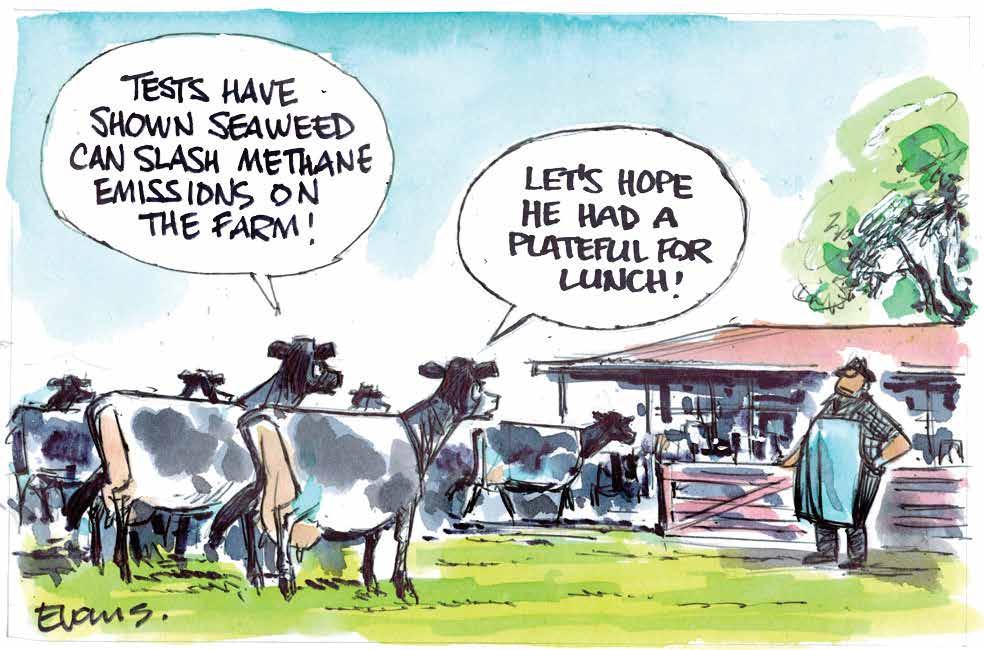
Too little, too late
ECONOMISTS, IN their usual excitable tones, have, for a while now, been openly questioning the Reserve Bank’s glacially slow reaction to the recessionary economic conditions we’re all drowning in.
ASB’s October RBNZ Preview was one example: “We are increasingly concerned that the OCR is very high relative to a more neutral level in an economy where inflation pressures and capacity have in effect already normalised.”
Translation: The RBNZ has crashed the economy and urgently needs to cut the OCR In the first week of October, ASB was expecting two 50bp cuts in 2024 (last week the RBNZ dropped the OCR by 50bp) and a further 25bp cut in February 2025- with one of their economists saying, “the largest regret now facing the RBNZ is moving too little, too late”.
IT SEEMS Greenpeace is upping its long-running but ineffective public campaign against Fonterra.
Last week, a group of activists scaled the dryer at Fonterra Te Rapa before unfurling a banner labelling the country’s biggest export earner a climate polluter. Greenpeace is also suing Fonterra for claiming its Anchor brand butter is 100% New Zealand grass-fed. An online petition to stop Fonterra from using palm kernel expeller is also being run.
Why this sudden burst of activism? Milking It reckons it’s to do with Fonterra announcing a massive $1.1b profit last year and its secondhighest milk price forecast on record for its hard-working farmers.
It’s clear Greenpeace cannot bear a successful Fonterra. Definitely, a case of sour grapes!
China’s dairy pain
IT WAS only in 2018 that the Chinese Government embarked on a mission to lift domestic milk production and stop billions of dollars from leaving the country and into the hands of exporters like New Zealand.
It paid off. Chinese net total dairy product import volumes fell 15.7% year on year in 2023, with imports of whole milk powder - a major New Zealand export product - down 395.
However, six years later over-leveraged Chinese farmers are dumping milk and culling cows because it’s no longer financially viable to be a dairy farmer.
Demand for milk has fallen in China because of a slowing birth rate and a broader pullback in consumer spending, a hallmark of China’s struggle to recover its economy.
Now, the Government is rolling out stimulus packages to help dairy farmers.
A drop in China’s milk production may be good news for NZ exporters. China’s pain could be NZ’s gain.
Tatua’s just too-good EARLIER THIS month, small Waikato milk processor Tatua reminded the country that it’s still number one when it comes to paying farmers for their milk.
A final payout of $10.50/kgMS means Tatua’s 107 supplying shareholders will get over $2/ kgMS more than other farmers around the country - a hard pill to swallow for some farmers, who are struggling to raise their businesses out of deficits.
The question is what is Tatua’s point of difference? It can’t be size because apart from Fonterra, other processors –Miraka, Westland, Synlait and even Open Country Dairy- are almost the same size as Tatua.
Farmers won’t be wrong in asking - if Tatua can do it, why not their processor?
OUR HEARTS go out to the farmers and rural communities in Southland and Otago who are battling an onslaught of adverse weather.
Otago farmers were amid a drought a few weeks ago with the region being declared an adverse event for this reason. Then almost overnight, the region has been swamped by rain. What can one say?
In the case of Southland, it’s been wet and cold for months now and the new rains have just made the problem worse, and looking ahead, the weather forecasts don’t offer any respite.
The result is feed shortages for animals and, in the case of Otago, potential delays in getting crops in the ground with pastures inundated and potentially damaged. As we go to press, the full extent of the damage in Otago is still unknown as farmers are too busy trying to get basic infrastructure back in operation – for example, milking sheds –and haven’t had time to stop and properly assess the damage to their farms.
In Southland the misery continues. There are now concerns for the mental health of farming families and Federated Farmers is doing a significant publicity awareness programme to tell farmers where to go to get help; also urging them to look after themselves, get some rest, and rightly pointing out that decisions made when people are tired may not always be the best ones.
All this comes at a time when the farming sector continues to face pressure in multiple directions: lower prices for lamb, still-high interest rates and land use change which poses a serious threat to our livestock sector and the NZ economy.
Sadly, it seems adverse events are now almost a way of life. The effects of Cyclone Gabrielle and other adverse weather events along the east coast of the North Island are still being felt, with some farmers there still without proper access to their farms.
It’s said that farmers and rural communities are resilient and come together in a crisis, but this is surely being tested now on an ongoing basis.
Head Office: Lower Ground Floor, 29 Northcroft St, Takapuna, Auckland 0622
Phone 09-307 0399.
Postal Address: PO Box 331100, Takapuna, Auckland 0740 Published by: Rural News Group Printed by: Inkwise NZ Ltd Contacts: Editorial: sudeshk@ruralnews.co.nz Advertising material: davef@ruralnews.co.nz Rural News on-line: www.ruralnews.co.nz
Subscriptions: subsrndn@ruralnews.co.nz
Publisher: Brian Hight Ph 09-307 0399
General Manager: Adam Fricker Ph 021-842 226
Editor: Sudesh Kissun Ph 021-963 177
Machinery Editor: Mark Daniel Ph 021-906 723
markd@ruralnews.co.nz
Reporters: Peter Burke Ph 021-224 2184 peterb@ruralnews.co.nz
Subscriptions: Julie Beech Ph 021-190 3144
Production: Dave Ferguson Ph 027-272 5372
Becky Williams Ph 021-100 4831
Digital Strategist: Jessica Marshall Ph 021 0232 6446
AUCKLAND SALES CONTACT: Stephen Pollard Ph 021-963 166 stephenp@ruralnews.co.nz
WAIKATO & WELLINGTON SALES CONTACT: Lisa Wise Ph 027-369 9218 lisaw@ruralnews.co.nz
SOUTH ISLAND SALES REPRESENTATIVE: Kaye Sutherland Ph 021-221 1994 kayes@ruralnews.co.nz


WE ALL need energy to live the lives that we aspire to.
We need energy to survive; energy to produce food; energy to provide a home; energy to keep warm; energy to better our lives.
The Stone Age man needed energy in the way of fire to keep warm and to cook their meat. Imagine if we only used wood as our energy source; didn’t use gas, coal, or fossil fuels of any sort. How many trees would be left now and where would we be now? Stone Age man evolved into using fire energy to heat metals to make tools to help make their lives easier. Currently we use various minerals to process into metals to be able to
make the tools, machines, computers, to produce the medicines we need to sustain our growth – and all these processes need energy to undertake.
We use electricity in many processes and we need energy to generate that electricity. We use electricity in many ways in our homes, factories, hospitals and even in Parliament to allow our politicians to debate, whether for better or worse.
The majority of our energy has over time been produced using fossil fuel but we now see people wanting to stop us from creating energy by using fossil fuels to protect the


environment, yet they still use the resources that the energy has provided for all of us to use.
Everyone wants a better health system, more hospitals, more doctors, more nurses, but
to achieve this we need more buildings, and to do this we need more resources to use to build these, but we also need more energy - either to mine the products or to produce the equipment that goes into the hospitals.
This report looks at the many factors that are drawing farmers to new Farm Technology, from labour shortages to a drive for more profit. The list of tech solutions is huge: Satellite and GPS technology, sensors, smart irrigation, drones and automation, mobile apps, farm management software are just a few areas where tech is helping farmers improve their productivity.
To be in this special report contact your advertising representative now to promote your products and/or service to all NZ dairy farmers and sharemilkers.
Whatever we do, it takes energy and without energy we won’t survive.
Even those people who talk carbon neutral businesses don’t seem to take into account the energy used in the first place to produce the office, house, factories etc which we currently have.
We use water, gas, coal, fossil fuels, wind, sun, geothermal, and nuclear energy to provide us with better lives.
We in the western countries tend to take energy as a god-given right but think we should
halt any further use of fossil fuels to produce energy as it’s going to stop climate change.
Yet in the world’s developing nations they want what we have and need energy to reach a better standard of living.
Why can’t those people in the world’s developing nations have what we have, which took energy to create? They need the energy to get those resources and products that we have already and in most cases the fossil fuel they use is mainly coal.
Even though you may think that we don’t need energy daily, in fact we do. We all need energy for health, warmth, travel, survival; in actual fact we need it for most everything.
• Peter Buckley is an executive of the Primary Land User Group (PLUG).
FEATURE: 29 October 2024 BOOKING DEADLINE: 16 OCTOBER 2024 MATERIAL REQUIRED: 22 OCTOBER 2024

ANNA KALMA is Smaller Milk and Supply Herds (SMASH’s) national coordinator and has seen it all in her time on the national committee.
SMASH was established in 2010 with the goal of supporting dairy farmers with smaller than average-sized herds. Since then it has evolved and grown in popularity, and now farmers with herds of all sizes come to its well-attended events.
“I joined the SMASH committee in 2016 after hosting a field day on my farm,” says Kalma.
“It was during the $3.90 payout year, so things were pretty grim. I remember meeting somebody a few years later who said the discussion around managing FWE, and some of the sentiments shared on the day, really encouraged them at a time when they were thinking about ditching farming.”
This is a common thread in the feedback from SMASH events, that the topics are practical and relevant to current farmer issues, and there is a really supportive community feel to them.
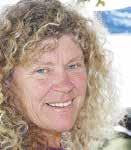

Kalma is enthusiastic about her involvement in SMASH which she says has plenty of upsides.
“I enjoy meeting farmers from around the country, learning about their systems and regional differences. We get great feedback from those who attend our events, and the lunches put on by the locals, especially the primary school PTAs, are great.
“And then there are
our committee meetings, often off-topic and disorganised, but run by a fantastic group of enthusiastic volunteer farmers with heaps of ideas.
“It is also a novelty being recognised as a SMASH person on the street, including once in New York City!”
She also has plenty of stories about her adventures on the road, and what goes on behind the scenes when pulling

events together.
“The weather is always a huge factor – postponed events, speakers missing flights, hosts deciding to take us for a long walk to the cows only for the heavens to open. I was stopped by floods when I was trying to get to Whangarei in 2023 and getting ready to stay in an emergency shelter when one of our sponsors saved me as she had managed to book a motel.
I got through the next day to run the event.
“Then there are the portaloos. Dragging one over the ranges to get to Karamea on the West Coast, and through road diversions in Northland and then getting pulled over by a road worker because one of the stabilising legs had dropped down and gouged a furrow for who knows how long in the dirt road. The portaloo
door opening mid-trip to unleash all the toilet rolls.
“And Covid! Trying to get permission to travel through Auckland during their lockdown, additional hygiene regulations, speaker no-shows when they come down with Covid, and cancelled events…”
At the end of the day the positive response from farmers is the primary factor encouraging the SMASH team to con-
“We get great feedback from those who attend our events, and the lunches put on by the locals, especially the primary school PTAs, are great.”
tinue. They work together like a well-oiled machine, which is a testimony to the people involved, their good-will and dedication to supporting the industry. They also couldn’t do it without the staunch support of their sponsorship team (Ballance AgriNutrients, Barenbrug, BNZ, FMG, LIC, and Pioneer), some of whom have been on-board since the start, and their major partner, DairyNZ. Upcoming events, which are held throughout New Zealand, are publicised on the SMASH website (www.smallerherds.co.nz) and Facebook page (www. facebook.com/smashdairynz).
• Louise Hanlon is executive secretary of SMASH


Taking care of their local environment is something many New Zealanders feel passionate about. On any given day throughout the country, you’re likely to find teams of volunteers engaged in clearing weeds, planting trees or cleaning up waterways.
The Westpac Water Care Project was established to give those passionate volunteers an extra helping hand, as part of the partnership between Westpac NZ and NZ Landcare Trust. The programme which began in 2022, sees Westpac provide six catchment groups each year with a $10k grant to support a local conservation project.
“Supporting our rural communities is an incredibly important part of what we do at Westpac,” says Westpac NZ Head of Agribusiness Tim Henshaw. “We went into this partnership with NZ Landcare Trust to try and make a difference at a grassroots level – helping groups across the country to protect and enhance their local environment.”
“There are so many passionate people out there keen to get stuck into improving waterways in their own backyards. The Westpac Water Care Project means we have the opportunity to make some of their ideas a reality.”
All Westpac employees receive two volunteer days each year to lend a hand to a cause of their choice and Mr Henshaw says many teams opt to use theirs to help grant recipients with their projects.
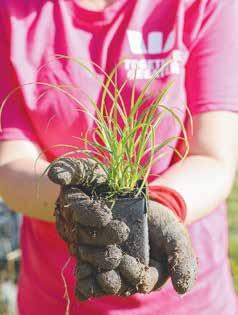
“I know lots of our teams have really enjoyed getting their boots dirty and helping to make a difference in their communities.”
To date, 18 groups have received Westpac Water Care Project grants. NZ Landcare Trust CEO Dr Nick Edgar says it’s been positive to see the results achieved by grant recipients.

“The aims of the different projects have been really diverse, meaning we’ve seen a fantastic range of initiatives undertaken. Grants have enabled catchment groups to do everything from fencing planting areas through to creating new wetland areas, improving animal crossings and restoring native bush,” Dr Edgar says.
Recipients of the Canterbury Westpac Water Care Project grant, Summit Road Society, owns much of the Avoca Valley catchment. The Society is focused on restoring the environment throughout the valley and volunteers involved in the
project have been working hard to do so over the past few years.
Through restoring the native bush in Avoca Valley, other positive environmental outcomes will also result, including creating habitats for native wildlife, enhancing freshwater quality and reducing erosion and sediment run-off.
The Society applied for a grant to help it to purchase trees, which it then organised volunteers to plant. More than 1600 trees were planted in the Avoca Valley through four community planting days in May and June 2024. The group also organised a planting day with the local kura kaupapa Māori (Māori language immersion school), where 25 tamariki helped to plant 100 trees near a spring site. In addition, 100 native plants and trees were given to valley neighbours, for them to plant along the stream running through their properties.
Summit Road Society General Manager, Bill Martin says it’s been great to have support from the Westpac Water Care Project grant.
“We’re really proud of what we’ve achieved in the valley so far and are grateful to everyone who’s played a part. Over the past three years, we’ve planted more than 53,000 natives throughout the valley. Ultimately, we’re aiming to plant a further 35,000-40,000 to complete the restoration of Avoca Valley stream.
If you’re interested in supporting the Summit Road Society and restoration of the Avoca Valley catchment, get in touch with/visit https://www.facebook.com/ summitroadsociety
Applications for the 2025 Westpac Water Care grants will open in 2025. For more information, visit https://landcare.org.nz/ project/westpac-water-care-project/
mudfish and tadpole shrimp have been discovered at an environmental restoration site at Bennetts Stream in North Canterbury which is part of a biodiversity initiative being carried out by Waimakariri Irrigation Limited (WIL).
The Bennetts Stream restoration project began five years ago as part of a wider biodiversity project focused on improving sites of ecological interest across the irrigation scheme’s 44,000-hectare command area.
WIL biodiversity project lead Dan Cameron says the visual identification of 10 threatened Canterbury mudfish at Bennetts Stream in January followed by two tadpole shrimp in September raises several interesting questions regarding the role these species play in the ecosystem and how this will shape the future of the restoration project.
“It was a huge surprise to find Canterbury mudfish at the site as there are no known records of this species north of the Waimakariri River, apart from at Coopers Creek near Oxford.
“Unfortunately, a couple of months after we found the mudfish the stream went dry, and water only started flowing through this ephemeral stream again this month. We didn’t find any mudfish when we did our recent trapping exercise, so we don’t know yet whether the mudfish we found in January are still here. We are not sure if they could be a remnant population or if they were translocated here through a natural process such as a flood.”
The recent discovery of rare tadpole shrimps at the restoration site has prompted Dan to consider further investigations to understand what other species could be living in Bennetts Stream and how their lifecycles interact with the unique
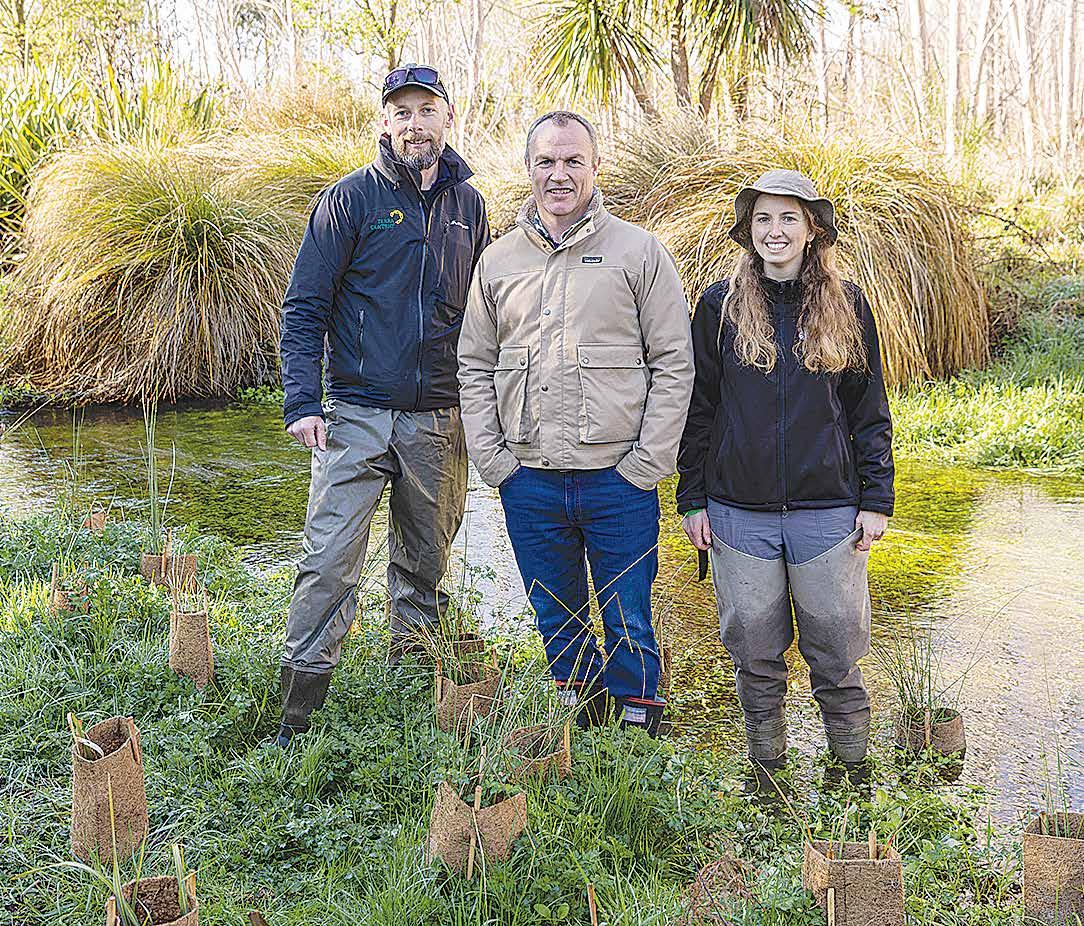
nature of an ephemeral stream ecosystem.
Tadpole shrimps are classified as “living fossils” as they are an ancient species with the oldest fossil ever discovered dating back to the Upper Carboniferous period (approximately 300 million years ago). Found only in New Zealand and Australia, they are known as shield shrimps due to the shell type structure that wraps around their body.
Tadpole shrimp require a specific habitat which dries up and must remain dry for some time for their lifecycle to be completed. The eggs of the tadpole shrimp hatch once a waterway or pond is refilled with water.
Dan says tadpole shrimp have been found in the Hawke’s Bay and in Canterbury.
“There have been limited numbers of tadpole shrimp recorded in Canterbury so the discovery of both tadpole shrimp
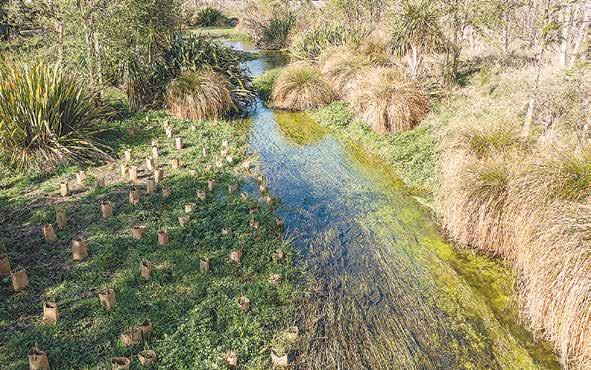
and Canterbury mudfish means that we will need to broaden our knowledge about the role they play in this ecosystem.”
WIL board director and local farmer Tim Wells started working on the Bennetts Stream project in 2019 with a focus on the removal of gorse and blackberry and car-
rying out native planting. He explains that the impetus for the project was in response to Plan Change 7 (PC7).
“WIL created a solutions package in response to Plan Change 7 which focused on biodiversity restoration within the area covered by our irrigation scheme, along
with Managed Aquifer Recharge (MAR) and Targeted Stream Augmentation (TSA). I identified this site as a good way for farmers and the irrigation cooperative to make a difference as the stream is surrounded by WIL shareholder properties. We want to be part of the solution to the
ariri District Council. Dan says with a large, longterm ecological restoration project such as this one, it is vital to work together with other partners.
“Working with stakeholders strongly underpins the success of the project as when we work together, we share resources, effort and enthusiasm. A great example of this is West Eyreton School where students have been raising native seedlings in a greenhouse supplied by WIL and then planting their seedlings here at the site.
“As the next generation, they are working to improve biodiversity in their backyard and that sense of kaitiakitanga (guardianship) is really strong, so it creates a very positive connection between the students and this particular site.”
The next step in the project is environmental DNA (eDNA) sampling which will help to confirm if Canterbury mudfish are present and provide a more detailed picture of the different types of species living in Bennetts Stream.
“We will take samples from the stream and analyse these to determine traces of DNA in the samples. We can then understand more about what is living in the stream from species of fish right down to small invertebrates, microorganisms and algae.
water quality issues that we have here in Waimakariri.”
Tim says that the long-term goal is for WIL to create a recreational space which can be enjoyed by everyone.
West Eyreton School is involved in the project, along with Environment Canterbury and Waimak-
“This will help us to decide which actions to take next and will also help to determine a longterm plan for the site. Ultimately, we want to create a self-sustaining site with thriving indigenous biodiversity, but we want to spend more time understanding this ecosystem first.
“We need to determine how all of the different elements at this site impact each other so we can create a long-term plan to enhance and preserve this special space for future generations to enjoy.”
A NEW collaboration is underway to improve the genetic links between the New Zealand and Nordic Jersey cattle populations.
Breeding companies LIC and VikingGenetics will work together on a pilot project that aims to bridge the genetic strengths of the two regions’ dairy industries. This involves exchanging sexed semen which allows LIC and VikingGenetics to identify new bloodlines that perform well in their own dairy farming environments.
LIC says its Jersey bulls are renowned for siring highly fertile, efficient, medium-sized cows that consistently produce high percentages of milk solids. Their ability to convert feed into milk with exceptional efficiency has cemented their role as an asset in New Zealand’s dairy
industry, says LIC.
“We are deeply committed to safeguarding the future of the Jersey breed in New Zealand and worldwide,” says LIC chief scientist Richard Spelman.
“This forward-thinking solution will create stronger genetic connections between the Nordic and New Zealand Jersey populations and reduce the risk of inbreeding. We look forward to being able to offer more genetic diversity to our New Zealand Jersey herds in the coming years,” he adds.
VikingJersey bulls are renowned for siring profitable, medium-sized cows with exceptional health and fertility. They are breed leaders in fat and protein percentages, purebred Jerseys, free of monogenetic disorders, and offer A2A2 and BB caseins.

“This collaboration is a step forward in the overall genetic landscape of the Jersey breed, offering breeders a sustainable way to enhance herd health and profitability,” says Peter Larson, product manager for VikingJersey and senior
breeding manager at VikingGenetics.
“By sharing Jersey genetics internationally, we are helping dairy farmers identify the most beneficial bloodlines that bring superior value to their herds, whether they are from the Nor-
MICHAEL AND Cherie Berkers’ Holstein Friesian herd exemplifies how breeders can consistently develop successful cow families by seizing opportunities for improvement year after year.
Their Riverton sharemilking business, Moovin Aherd Ltd, has three heifers included in this year’s Discovery Project team, which features 24 heifers from 16 breeders across New Zealand.
The Discovery Project, a collaboration between Holstein Friesian NZ and LIC, focuses on identifying exceptional Holstein Friesian heifers with the potential to significantly impact the AI industry.
Each heifer selected participates in a Trans-Vaginal Recovery (TVR) programme, utilising advanced breeding technologies to produce genetically superior offspring, driving the evolution and enhancement of the Holstein Friesian breed.
This year, the Berkers successfully nominated three heifers: MAH Freestyle Sambie S1F (454/46gBW), sired by Prattleys Lucid Free-Style S1F and out of MAH Samba-ET S2F; MAH Lucid Indie (442/55gBW), sired by Woodcote VHR Lucid-ET S1F and out of MAH Grand Imogin S1F; and MAH Lucid Storm S1F (507/56gBW), sired by Woodcote VHR Lucid-ET

S1F and out of MAH Fury StormET S2F.
Cherie says Woodcote VHR Lucid-ET S1F, a bull out of 2018 Discovery Project team member Woodcote FU Laura-ET S3F VG85, was a sexed semen sire that resulted in many daughters.
“They are really nice calves,” Cherie says. “We use sexed semen on our best animals, and the results have been excellent.”
The Berkers have been nominating heifers for the Discovery Project on and off over the years.
One of their first pedigree animals, 2014-born MAH HDF Starstruck-ET S3F, participated in the 2015 Discovery Project. Embryos were collected in the spring of that
year, and calves were born in 2016. All three of her daughters went through the Discovery Project.
“The Discovery Project is a valuable programme,” Cherie says. “LIC provides support with sire recommendations for mating, as well as free semen, including from bulls that are not yet publicly available.”
HFNZ also offers discounted classification to all Discovery Project heifers when they are classified as two-year-olds.
Holstein Friesian NZ encourages its members to nominate their high BW heifer calves for the 2025 Discovery Project through the HFNZ website. Nominations close on February 21, 2025.
dics, New Zealand, or elsewhere,” adds Lars Nielsen, VikingGenetics’ chief breeding and production officer.
The collaboration will help address concerns over inbreeding within the two populations. Selected cows will be
inseminated with sexed semen from top genomic sires, using stringent selection criteria to achieve the best genetic results. All progeny will undergo comprehensive testing, verifying their parentage, data from milk recording, health reg-
istration and classification, and more. Between 10 and 20 bulls from each company will be enrolled in the project annually. The goal is to have the best sires forming part of future breeding schemes.
Tes project is a breeding collaboration and only extends to the exchange of genotypes for breeding purposes and not the market distribution of doses.
VikingGenetics is a cattle breeding co-operative owned by more than 16,000 dairy and beef farmers in Denmark, Sweden, and Finland. They focus on animal welfare, food security, and reducing climate impact in the entire production chain. The company says with its solutions, customers can continuously improve the genetic gain for each generation of their herd.

Gain knowledge and practical skills.
Lameness is now amongst the top three health issues on-farm and it is costing New Zealand dairy farmers millions of dollars every year.
Course Information:
ASHBURTON: 2 - 6 December 2024 and 5 - 9 May 2025
BOOK NOW: $2,750 + gst per person
This is an intensive 5-day course aimed at those who are serious about minimising lameness through gaining a more comprehensive understanding of the contributing factors, as well as becoming competent in the technical aspects of hoof trimming. Led by our director Fred Hoekstra, who is NZ’s only fully qualified hoof care instructor. Register today at dhi.ac.nz

The course was brilliant- it was some of the best learning that I have ever had, I certainly feel more equipped to work with farmers and other vets in hoof trimming and treatment, as well as in a lameness advisory role. The experience has been invaluable to my future career. Kate Mackersey, Massey University Vet Student

Group has announced several upgrades to its round baler ranges for 2025, much of it centred around automation, as well as the ability to wrap bales with film rather than net.
Tractor Implement Management (TIM), moisture sensing and the ability to tie the bale using film in place of net wrap, are just some of the upgrades for Vicon round balers for next season.
TIM is available on the fixed chamber FixBale 500, alongside the RV5200 Plus-series variable chamber balers, offering an ISOBUS solution, allowing the balers
to automatically carry out repetitive operations and manage key tractor functions, when used with any TIM-compatible tractor.
Functions include pre-programmed tractor deceleration, pausing baling and applying net wrap and opening and closing the tailgate. Designers have also integrated an inclinometer to prevent unsafe, automated bale ejection on steeper slopes.
From operational and safety standpoints, after bale ejection the system needs acknowledgement from the operator to resume the baling process, with confirmation instigating a pre-programmed rate of acceleration to the desired forward speed for

the volume of crop being baled.
Following several modifications, including additional rollers for the PowerBind net application system, the FixBale 500 model is available with a film bind-
option.
gather the material into a tail to assist with the start and finish of the film binding cycle, with the ability to handle a wide range of pre-stretch ratios and film roll widths
The 2025 RV5200 Plus-series balers can be equipped with a TechnoPack, which adds crop humidity measurement to the range. In practice, a sensor plate mounted in the lower part of the bale
chamber is equipped with a pair of electrodes which pass an electric current through the incoming crop.
This resultant data is used to calculate the moisture content in the bale, displayed in real
time, with the ability to detect levels up to around 50%.
In other Kverneland news, back in July a team from Kverneland Sweden set out to establish a world record for the number of round bales produced by on machine in 24 hours.
Baling in 105 hectares of a heavy pre-cut crop, a 240hp tractor and a Kverneland Non-Stop FastBale Premium combination set a new world record of 1587 wrapped bales.
The record was achieved under full practical conditions, including travel time between fields, machine maintenance, and the replacement of net/film, all factored into the overall baling time.
starts by cutting the crop at the correct growth stage, followed by reducing moisture content, chopping to a consistent length, then stacking in a clamp.
The latter function relies on placing thinner, even layers across the width and length of the clamp and quickly excluding air.
While easy in theory, the outputs of modern self-propelled forage harvesters can mean the ‘pit man’ can have his work cut out in achieving the desired result.
The process of removing air to
achieve an anaerobic fermentation to reduce nutrient loss is achieved by compaction, created by rolling –typically by the buckraking tractor or loading shovel. In large clamps, operators often work in tandem with a second tractor, but in smaller operations or restricted areas, this is not always possible.
Over the last decade or so, homemade solutions include old railway carriage wheels carried in a frame to achieve compaction, but more recently several implement manufacturers have come up with their own

• High Flow
• Compact/Robust
• New Pilot Flow Filter
• Side/Bottom Mount
• Detach to Clean

solutions.
This issue has not been left unaddressed by the farm machinery industry, which has produced various rollers to work pits over the years, but now Walter Watson Agriculture of County Down, Northern Ireland, has brought its own answer to the problem to market.
Recently exhibited at the Irish Ploughing Match, the Watson Silage Compactor has evolved from the company’s well-known flat roller range to achieve increased compaction with rings or collars, topped off
with broad teeth around the perimeter.
Covering a 2.5m wide working width to match the overall width of typical medium horsepower tractors, when ballasted with water, the unit tips the scales at round 3.5 tonnes, with the manufacturer suggesting that as all up weight is an advantage, a tractor of around 150hp is needed for ease of handling.
Allowing the roller to work right up to the edges of a clamp, rams on each side of the machine allow a 500mm side-shift function, ensur-
ing that the tractor can be kept safely away from the edges.
Attention to detail sees the fitting of a polypropylene roller at each corner of the unit to prevent the machine scraping along the side of any walled clamps, so preserving both machine and wall.
Packing the silage into the clamp not only helps increase quality, but the increased density also saves space, with the manufacturer suggesting that the compactor can increase storage capacity by between 30 and 40%.
– Mark Daniel
• For Water Storage Tanks
• Adjustable levels from 50mm-2.5m
• Minimises pump operation
•Available in 20/25/32/50mm

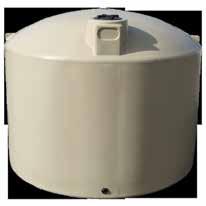

• Stainless steel bracket and Shaft
• Fits plastic and concrete tanks
• Rugged and long lasting
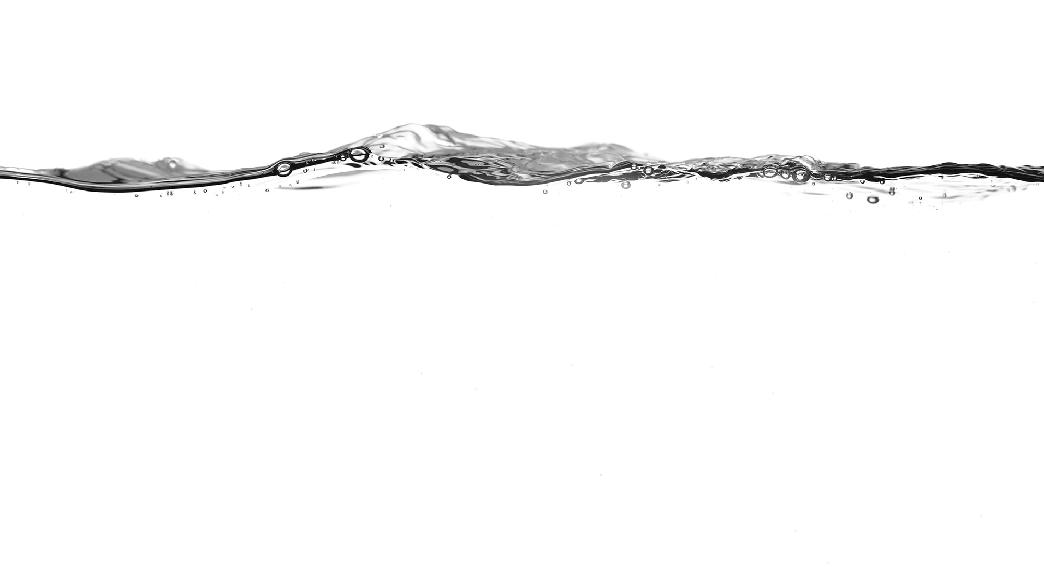
THE NEW Lemken Solitair MR series mounted drills, available in three or four metre working widths, features a 1500litre tank, which is suitable for fertiliser even in its basic configuration.
The tank is also available as a 2000-litre capac-
setting to each second row, to allow seeds to be placed at the same depth, even at high forward speeds and in changing soils, while the depth control roller subsequently presses the seeds down to ensure rapid and even emergence.
Distributor heads are positioned directly above the coulter bar and do not require a seed return
Seeds from the MultiHub are delivered via the existing seed lines or via a baffle plate system in front of or behind the harrows, offering the same number of width sections as the seed drill.
ity option, which can be split 60:40 on request for simultaneous application of several components. Either can be complemented by adding the 200-litre MultiHub to the tank, allowing mixed crop systems can be achieved in a single pass.
Seeds from the MultiHub are delivered via the existing seed lines or via a baffle plate system in front of or behind the harrows, offering the same number of width sections as the seed drill, with control fully integrated into the user interface of the ISOBUS terminal as an additional seed line.
The Solitair MR is equipped with the maintenance-free OptiDisc coulter bar with row spacings of 12.5 or 15cm, featuring parallelogramguided double disc coulters and trailing depth control rollers for uniform field emergence. The coulter system is available as a hydraulic version, with up to 70kg coulter pressure, or a mechanical version offering up to 45kg coulter pressure.
Coulter pressure and seed depth can each be adjusted independently of each other, which is useful when drilling mixed crops. This can be achieved by applying a separate drilling depth
function. The new Solitair is equipped with two metering systems, each supplying one distributor with seeds, so that even the basic configuration offers width section or half-width control, while a hydraulic tramline mechanism can also be added as an option.
For customers opting for the single or double shot version, the Solitair MR comes with four metering units for two width sections, with each tank connected to two metering units. This means that each of the two distributors can be supplied with both components (single shot) or each of the four distributors can be supplied with one component each (double shot).
Aimed at seedbed preparation to exploit the potential of the Solitair MR, the next generation of Lemken Zirkon MR rotary harrows offers the possibility of mounting the drill above the rear roller.
Approved for tractors up to 240hp, the new Zirkon MR features a new mounting system that ensures that the working depth of the rotary harrow and the sowing depth of the seed drill are each controlled independently. This makes it easier for customers to set up the machine to suit
individual circumstances, particularly so because the Zirkon offers hydraulic adjustment of the levelling bar and working depth.
Both the Solitair and the Zirkon rotary harrow are currently available in limited quantities, with series production commencing in 2025.

1: Collision Safety System:
If the mower happens to encounter an obstacle, the design of the hinge enables the mower to move simultaneously backwards and upwards to ride over the obstacle. Once the obstacle is cleared the mower automatically returns to the cutting position.
3: Hydro-pneumatic suspension:
The advanced suspension system ensures that the ground pressure is consistent across the entire cutterbar, resulting in a precise and clean cut.
2: Disc Drive Safety System:
The unique solution of four brass shear pins protects the cutter bar gears from impact and subsequential damage. This effective but simple solution enables the mower to be repaired easily and cost-effectively in the field, often by the tractor driver.
4: Three Year Warranty:

The SIP SILVERCUT range of mowers come standard with a full Two-Year Warranty, plus an additional third year of warranty subject to regular dealer servicing, resulting in worry free operation.






Now includes 15, 20 & 25mm Adaptors in Superflo Standard Adaptor Pack
The Hansen Superflo Valve has been design and built from the ground up to produce a High Performance Super Low Maintenance Valve. With it’s proven success it’s not difficult to see why so many farmers have embraced it. High Performance 188 L/min @

Slipper Fit Piston Helps Eliminate Stuck Valves





Multiple Size Options
Threaded Outlet for Portables, Washdown, Tanks, Irrigation


HAND TESTED
